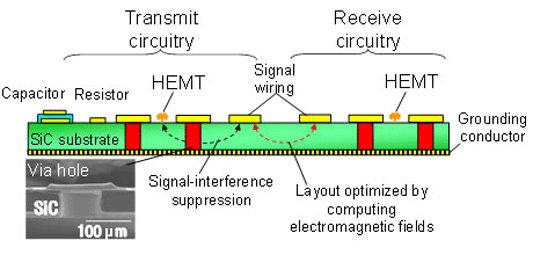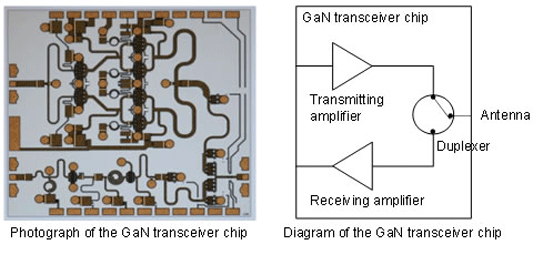- News
22 June 2012
Fujitsu develops first high-output, single-chip 10GHz transceiver using GaN HEMT
At the IEEE MTT-S International Microwave Symposium (IMS 2012) in Montreal, Canada (17-21 June), Fujitsu Laboratories of Kawasaki, Japan presented what it claims is the first high-output, single-chip transceiver that uses gallium nitride (GaN) high-electron-mobility transistor (HEMT) technology and operates in the 10GHz frequency band.
In line with the advancement of a network-based society, radio wave demand in a variety of wireless systems is expected to increase even further, notes Fujitsu. For example, aircraft radar uses the 10GHz frequency band, which can measure the distance and direction of physical objects with high precision.
Existing radars are configured with separate equipment for transmitters and receivers. In contrast, a transceiver chip that integrates both functions would enable everything to be integrated in one piece of equipment, allowing systems to be more compact.
The transceiver chips necessary to make radar and other equipment more compact must deliver high-capacity communications and high output in order to cover a large area. To simultaneously handle strong transmission signals and weak incoming signals in the same chip, it is necessary to efficiently switch between outgoing and incoming signals, while reducing the impact that outgoing signals have on incoming signals. However, until now, it has been technologically difficult to accomplish both of these objectives in tandem.
Fujitsu Laboratories says it has resolved this issue by developing a duplexer with low signal loss using a GaN HEMT, and through high-output circuit integration design technology that controls the signal interference between the outgoing and incoming signals. The result is a transceiver chip operating at 10GHz with output of 6.3W that measures just 3.6mm x 3.3mm (a footprint that is less than 10% of the size of the multiple chips that have been needed until now – see Figure 1).

Figure 1: Comparison of conventional transmit/receive switches and newly developed switch.
The firm says that, with this technology, it is now possible to configure a high-output transceiver using just one chip, enabling systems such as radar equipment and wireless communications equipment to be made more compact.
Features of the new transceiver chip are as follows:
- Ultra-compact transmit/receive switch. The GaN HEMT-based duplexer measures 1.8mm x 2.4mm, with 1.1dB transmission loss in the 0-12GHz range (much smaller and lighter than earlier switches using magnetic materials - less than 10% the size).
- High-output circuit integration design. Via holes for grounding are arrayed around the transistors, shielding against the release of unwanted signals. In addition, the locations and layouts of signal wiring and circuitry were optimized using three-dimensional analysis of electromagnetic radiation to suppress unwanted signal interference (see Figure 2). This ensures stable operation, preventing the oscillations of high-power circuitry from causing malfunctions.

Figure 2: Technologies to suppress unwanted signal interference.
These technologies were integrated into a single prototype chip that combines a duplexer, a transmitting amplifier, and a receiving amplifier (see Figure 3). The overall chip measures 3.6mm x 3.3mm, less than one-tenth the size of earlier multi-chip systems.

Figure 3: Photo and diagram of the newly developed GaN transceiver chip.
The new technology makes it possible to design a high-output transceiver around a single chip, with applications in radar and broadband communications, promising smaller, lighter systems, says Fujitsu.
Fujitsu Laboratories says that it intends the technology to be used in a wide range of applications that require compact modules with high output, including wireless communications and radar systems.
